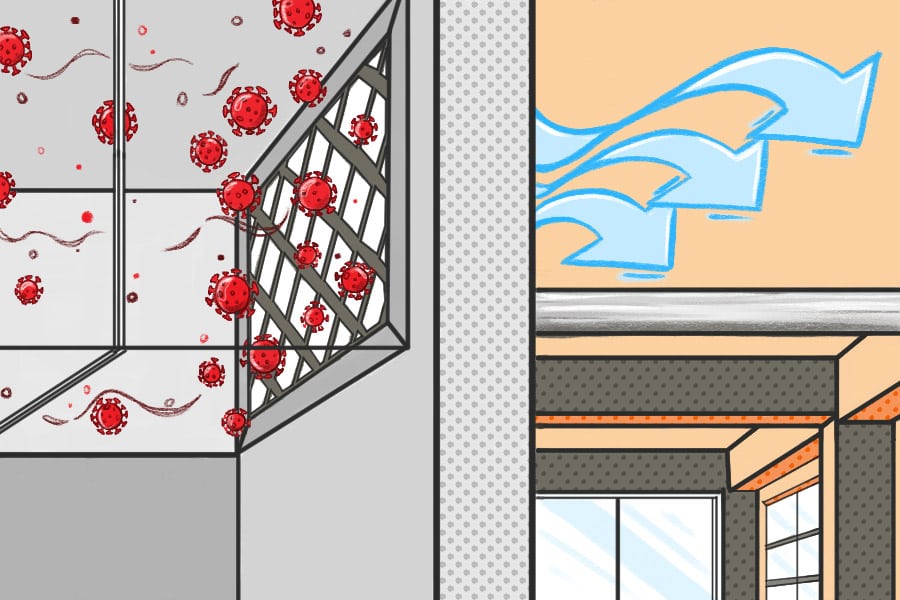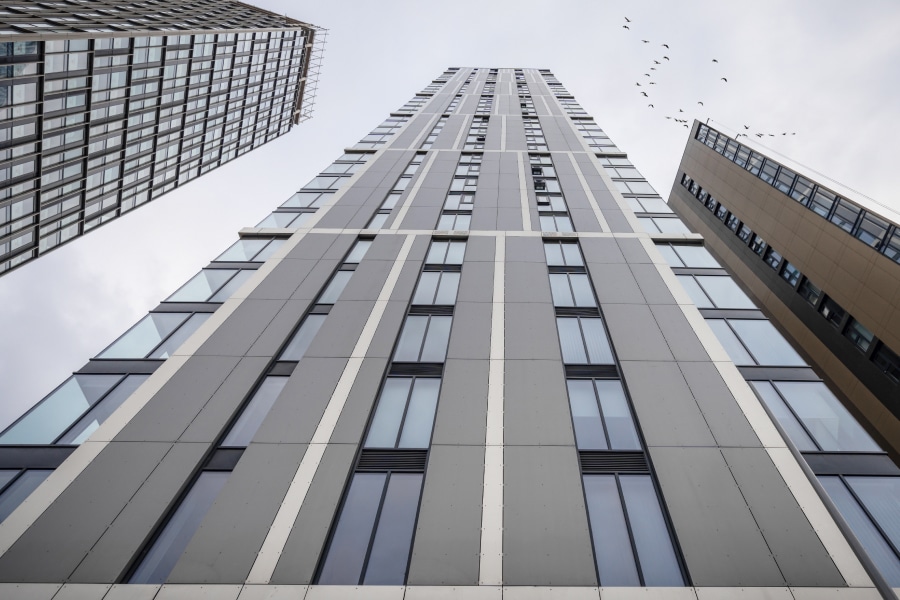Illustration by Sam Barks
Colder months are coming for countries in the Northern Hemisphere, which will likely result in a mass migration indoors across half of the world. Against the backdrop of the COVID-19 pandemic, the worst of which resides in the United States, colder temperatures will soon mitigate people’s ability to safely gather, exercise and socialize outdoors.
Moreover, as state-by-state restrictions ease, more companies will be welcoming back workers into reconfigured offices after months of remote work. All told, much of the world will be moving indoors during a time when many health experts predict the pandemic’s spread could be made worse as it exists in combination with the annual influenza season.
As people move largely inside for the fall and winter months and the U.S. continues to manage the re-opening of schools, evidence suggesting the virus can be transmitted through the air—aerosolized and inhaled—continues to accumulate.
Health experts have said for months that indoor areas, especially those with poor ventilation, are prime areas for the virus’ spread. While logical, the evidence that COVID-19 can spread through a building’s heating ventilation air conditioning systems (HVAC) is still not completely conclusive, but many businesses and buildings are investing time and money to maintain and upgrade their HVAC systems to improve air flow and filter out the virus.
“We have a fairly high level of confidence that COVID-19 transmission can be affected by air motion within a space,” according to William Bahnfleth, chair of American Society of Heating, Refrigerating and Air-Conditioning Engineers’ Epidemic Task Force. “We do not have direct evidence at this point that infections have been transmitted through HVAC from infected persons in one space to susceptible persons in another space.”
Enhanced air filtration
Simply making sure an HVAC system is operating as intended and providing fresh, clean air from outside is vital to reducing the spread of COVID-19 indoors. According to a September article in The Wall Street Journal, public indoor spaces should aim to have air replaced with clean air between four to six times an hour to dilute accumulated COVID-19 particles. This should be done through a combination of enhanced HVAC ventilation, open doors and windows, window fans, air purification and filtration, the Journal article said.
Perhaps most important, the article concluded, is ensuring indoors spaces are equipped to maintain outdoor air circulation throughout the indoor space.
The enhanced focus on indoor spaces has been a boon to the market for HVAC systems. Dennis Knight, vice chair of ASHRAE’s Epidemic Task Force, said he has seen increased demand for HVAC equipment since the pandemic began, with lead times doubling from six to 12 weeks in some cases.
Filters are also in demand as building operators seek to make sure HVAC systems don’t spread the virus from room to room. “Local suppliers and my clients have told me that MERV 13 filters … and portable HEPA filter units are difficult to obtain and the lead times … are quite long,” Knight said. (MERV, or Minimum Efficiency Reporting Value, is a number given to a filter that represents the smallest particles it can filter from the air.)
Only the highest levels (MERV 13-16) are capable of removing bacteria and viruses from the air, but simply installing a better filter isn’t always possible as tighter filters further impede air movement through the system, requiring more power to maintain good circulation. High-efficiency particulate air (HEPA) filters are more efficient than MERV 16, but require even more energy and maintenance to operate optimally.
The cost of adding filters depends on selectivity of the filter and the size of the HVAC system. In an email with the Bluebeam Blog, Knight provided an example:
“If the next strategy is to increase filtration from, say, MERV 8 filters to MERV 13, I have seen cost ranges quoted from as little as $0.05 per square foot of building to as high as $0.45 per square foot of building. The costs will vary by the type of filter, its filter frame size (1 inch thick, two inches thick, up to 12 inches thick) and the capacity of the existing HVAC system fan motors to overcome the additional pressure drop of the filters. If you are changing from a two-inch-thick MERV 8 to a 2-inch-thick MERV 13 electrostatically charged filter, the costs may be on the lower end of the range, but the filters may need to be changed more often. If you are changing from 2 inch MERV 8 thick filters to, say, 4- or 6-inch-thick filters MERV 13, all the way up to HEPA-rated filters, the filter frames, ductwork and fan motor horsepower, including electrical service to the equipment, may need to be upgraded and the costs will be significant. This level of upgrades typically requires designs to be prepared by licensed engineers and the installation to be performed by licensed contractors.”
Optimizing existing ventilation
So far in the schools he has worked with, Knight said the priorities have been optimizing existing ventilation and occasionally upgrading filters whenever it can be done without changing the size of the filter frame or overhauling the HVAC system. Other industries have spared fewer expenses.
“We have had discussions with some consultants working with larger office building portfolio owners in cities like New York who have stated that some of the building owners are installing nearly every mitigation strategy in their buildings,” Knight said.
Indoor air quality building codes vary by state, meaning there is no national standard for filter quality. Few buildings outside of laboratories and hospitals are required to be equipped with filters capable of trapping viruses, and updating building codes will take both time and political willpower.
For now, the safest option remains avoiding crowded indoor spaces. If people must be inside, buildings with certifications like WELL and LEED are more likely to adhere to higher filtration standards.











